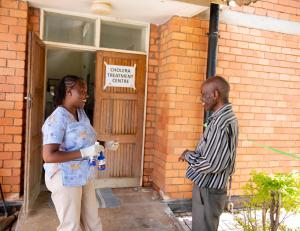Rallying to control the cholera outbreak in Zambia
Lusaka ‒ One evening, Lusaka resident Samuel Zyambo rapidly fell into a disturbing, dreamlike state of unconsciousness. He was unaware that when he woke up the following day, he was in a cholera treatment centre fighting for his life, with no recollection of anything that had taken place in the previous 12 hours.
“I had no idea where I was. There were people in beds all around me,” he says. Zyambo was in fact at a sports stadium that Zambia’s Ministry of Health converted into a state-of-the-art cholera treatment centre. “When the doctor told me I was at National Heroes Stadium, I couldn’t understand why I was in a place where I know they play football,” he recalls.
Zyambo, like tens of thousands of his fellow Zambians, contracted cholera, an acute, extremely virulent infection, during one the worst outbreaks in the country’s recent history. He says he owes his life to the rapid response of his family, who rushed him to the treatment centre, and the excellent care he received from health workers.
The outbreak peaked in January 2024, with Lusaka at its epicentre. Between 15 October 2023 and 23 July 2024, Zambia had recorded 23 382 cumulative cases and 740 deaths. No new cases have been reported since 11 July 2024, a sea change from the situation in January, when the country was recording an average of 461 new cases every 24 hours.
Government’s multi-faceted response, supported by World Health Organization (WHO) and other partners, included surveillance, infection prevention and control, case management, laboratory, community engagement and improvement of water, sanitation and hygiene services to control the outbreak. WHO dispatched 23 international experts to provide technical support in each of these response areas, who in turn trained over 800 health workers.
In addition to supplying 25 tons of medical supplies and equipment, including cholera kits, WHO upgraded seven community-based cholera treatment centers in Lusaka’s Chilanga, Chipata, George, and Matero sub districts and the Southern province’s Chipepo, Namoomba and Lumbembe areas. The Organization also provided infection and prevention, water, sanitation, and hygiene supplies to two other treatment centers.
In partnership with Gavi, the Vaccine Alliance, UNICEF, and others, WHO delivered 4.1 million cholera vaccine doses over two rounds to immunize people at high risk of infection in the worst affected areas to stem the outbreak.
“We've learned a number of lessons that I'm hoping we can have as part of our playbook for future responses,” says Dr Kalima Nawa, who was clinical manager at Heroes cholera treatment centre until its closure in late February 2024. “So ultimately, the hope is that what we are learning here allows us to have a sustainable, fast response to future outbreaks, not just the cholera outbreak, but other responses as well”.
Early detection and reporting at community level was a key outbreak response measure, with active case-finding teams visiting households daily to check for cases, ensuring early referral to health facilities, and mitigating further spread. Through its Integrated Disease Surveillance and Response platform, WHO provided tools and support with data analysis and interpretation.
“WHO plays a key role in the surveillance system in Zambia, not just for this cholera outbreak, but also for other outbreaks that we have in the country,” says Dr Kapina Muzala, Head of Surveillance at Zambia’s National Public Health Institute.
Although the outbreak is under control, WHO continues to support the country’s capacity for health emergency preparedness and response. The Organization partnered with UNICEF and the European Union, which provided funding until August 2024 to, among other things, address resource gaps in the cholera response plan, establish more oral rehydration points, improve the existing referral system, implement the community integrated cholera response plan, and procure critical cholera supplies as part of preparedness efforts for the next high cholera transmission season that starts in October 2024.
Cholera supplies security and adequate emergency preparedness were identified as gaps during the cholera intra-action review conducted in April 2024.
“The collaborative efforts that ensured we could contain the worst of the outbreak within a matter of months is proof of the value of concerted, coordinated action,” says Dr Nathan Bakyaita, WHO Representative in Zambia. “We must continue to work together to ensure that the lessons learned from this outbreak response strengthen the country’s emergency preparedness.”
Zyambo’s wife, Joyce, was also struck by cholera and was treated at the local cholera treatment unit in their neighbourhood Kalingalinga, while Zyambo was convalescing at Heroes. It was a week before they were reunited. “When I saw my wife, I felt very happy because we both survived this ordeal,” he says. Now the family follows strict guidelines to protect themselves from the disease, like boiling water for household consumption and regular hand washing.
Communications Officer
World Health Organization Country Office, Zambia
Email: kapemak [at] who.intdata-auth="NotApplicable" data-linkindex="0" id="LPlnk242245" rel="noopener noreferrer" target="_blank"
Communications and marketing officer
Tel: + 242 06 520 65 65 (WhatsApp)
Email: boakyeagyemangc [at] who.int




